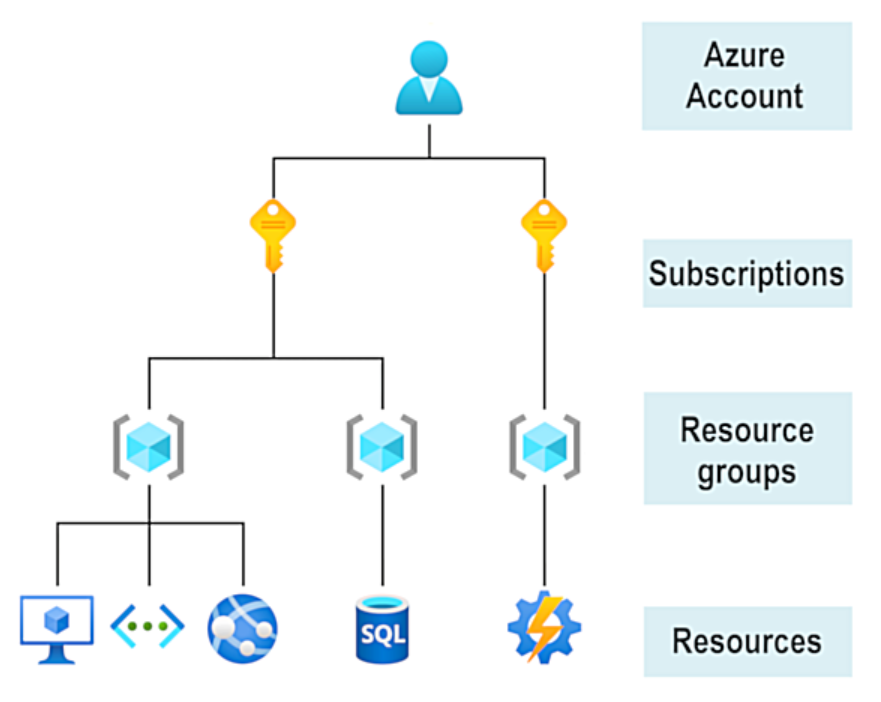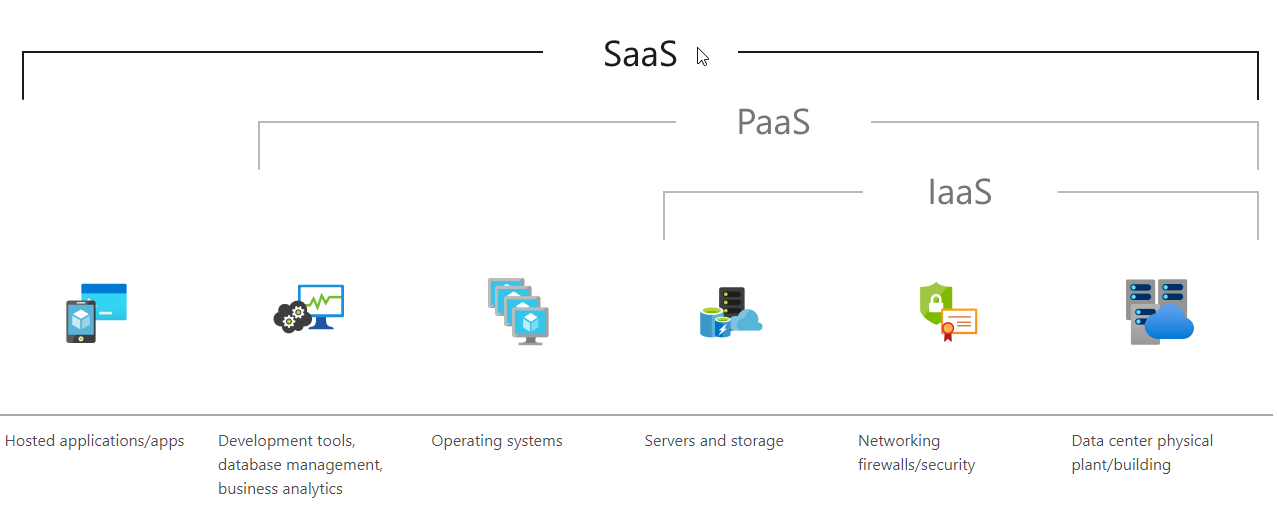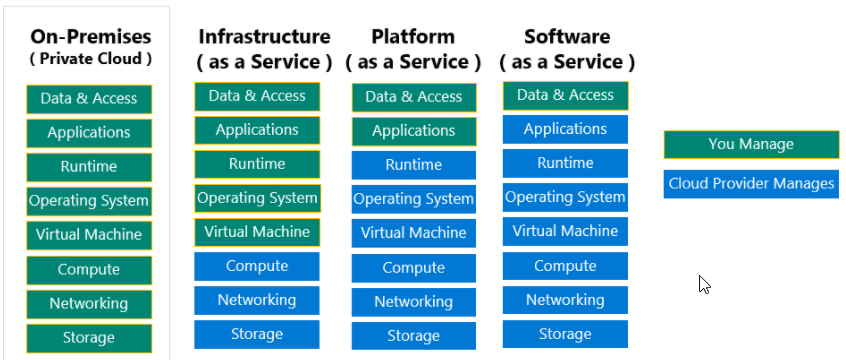Azure 10 main categories:
- Compute
| Service name | Service function |
| Azure Virtual Machines | Windows or Linux virtual machines (VMs) hosted in Azure. |
| Azure Virtual Machine Scale Sets | Scaling for Windows or Linux VMs hosted in Azure. |
| Azure Kubernetes Service | Cluster management for VMs that run containerized services. |
| Azure Service Fabric | Distributed systems platform that runs in Azure or on-premises. |
| Azure Batch | Managed service for parallel and high-performance computing applications. |
| Azure Container Instances | Containerized apps run on Azure without provisioning servers or VMs. |
| Azure Functions | An event-driven, serverless compute service. |
- Networking: Linking compute resources and providing access to applications is the key function of Azure networking
| Service name | Service function |
| Azure Virtual Network | Connects VMs to incoming virtual private network (VPN) connections. |
| Azure Load Balancer | Balances inbound and outbound connections to applications or service endpoints. |
| Azure Application Gateway | Optimizes app server farm delivery while increasing application security. |
| Azure VPN Gateway | Accesses Azure Virtual Networks through high-performance VPN gateways. |
| Azure DNS | Provides ultra-fast DNS responses and ultra-high domain availability. |
| Azure Content Delivery Network | Delivers high-bandwidth content to customers globally. |
| Azure DDoS Protection | Protects Azure-hosted applications from distributed denial of service (DDOS) attacks. |
| Azure Traffic Manager | Distributes network traffic across Azure regions worldwide. |
| Azure ExpressRoute | Connects to Azure over high-bandwidth dedicated secure connections. |
| Azure Network Watcher | Monitors and diagnoses network issues by using scenario-based analysis. |
| Azure Firewall | Implements high-security, high-availability firewall with unlimited scalability. |
| Azure Virtual WAN | Creates a unified wide area network (WAN) that connects local and remote sites. |
- Storage
| Service name | Service function |
| Azure Blob storage | Storage service for very large objects, such as video files or bitmaps. |
| Azure File storage | File shares that can be accessed and managed like a file server. |
| Azure Queue storage | A data store for queuing and reliably delivering messages between applications. |
| Azure Table storage | Table storage is a service that stores non-relational structured data (also known as structured NoSQL data) in the cloud, providing a key/attribute store with a schemaless design. |
- Mobile: Features that used to take time and increase project risks, such as adding corporate sign-in and then connecting to on-premises resources such as SAP, Oracle, SQL Server, and SharePoint, are now simple to include.
Other features of this service include:
-
- Offline data synchronization
- Connectivity to on-premises data
- Broadcasting push notifications
- autoscaling to match business neeeds
- Databases
| Service name | Service function |
| Azure Cosmos DB | Globally distributed database that supports NoSQL options. |
| Azure SQL Database | Fully managed relational database with auto-scale, integral intelligence, and robust security. |
| Azure Database for MySQL | Fully managed and scalable MySQL relational database with high availability and security. |
| Azure Database for PostgreSQL | Fully managed and scalable PostgreSQL relational database with high availability and security. |
| SQL Server on Azure Virtual Machines | Service that hosts enterprise SQL Server apps in the cloud |
| Azure Synapse Analytics | Fully managed data warehouse with integral security at every level of scale at no extra cost. |
| Azure Database Migration Service | Service that migrates databases to the cloud with no application code changes. |
| Azure Cache for Redis | Fully managed service caches frequently used and static data to reduce data and application latency. |
| Azure Database for MariaDB | Fully managed and scalable MariaDB relational database with high availability and security. |
- Web
| Service name | Service function |
| Azure App Service | Quickly create powerful cloud web-based apps. |
| Azure Notification Hubs | Send push notifications to any platform from any back end. |
| Azure API Management | Publish APIs to developers, partners, and employees securely and at scale. |
| Azure Cognitive Search | Deploy this fully managed search as a service. |
| Web Apps feature of Azure App Service | Create and deploy mission-critical web apps at scale. |
| Azure SignalR Service | Add real-time web functionalities easily. |
- Internet of Things(IoT)
| Service name | Description |
| IoT Central | Fully managed global IoT software as a service (SaaS) solution that makes it easy to connect, monitor, and manage IoT assets at scale. |
| Azure IoT Hub | Messaging hub that provides secure communications between and monitoring of millions of IoT devices. |
| IoT Edge | Fully managed service that allows data analysis models to be pushed directly onto IoT devices, which allows them to react quickly to state changes without needing to consult cloud-based AI models. |
- Big data
| Service name | Description |
| Azure Synapse Analytics | Run analytics at a massive scale by using a cloud-based enterprise data warehouse that takes advantage of massively parallel processing to run complex queries quickly across petabytes of data. |
|
Azure HDInsight |
Process massive amounts of data with managed clusters of Hadoop clusters in the cloud. |
| Azure Databricks | Integrate this collaborative Apache Spark-based analytics service with other big data services in Azure. |
- AI
| Service name | Description |
| Azure Machine Learning Service | Cloud-based environment you can use to develop, train, test, deploy, manage, and track machine learning models. It can auto-generate a model and auto-tune it for you. It will let you start training on your local machine, and then scale out to the cloud. |
| Azure ML Studio | Collaborative visual workspace where you can build, test, and deploy machine learning solutions by using prebuilt machine learning algorithms and data-handling modules. |
| Vision | Use image-processing algorithms to smartly identify, caption, index, and moderate your pictures and videos. |
| Speech | Convert spoken audio into text, use voice for verification, or add speaker recognition to your app. |
| Knowledge mapping | Map complex information and data to solve tasks such as intelligent recommendations and semantic search. |
| Bing Search | Add Bing Search APIs to your apps and harness the ability to comb billions of webpages, images, videos, and news with a single API call. |
| Natural Language processing | Allow your apps to process natural language with prebuilt scripts, evaluate sentiment, and learn how to recognize what users want. |
- DevOps
| Service name | Description |
| Azure DevOps | Use development collaboration tools such as high-performance pipelines, free private Git repositories, configurable Kanban boards, and extensive automated and cloud-based load testing. Formerly known as Visual Studio Team Services. |
| Azure DevTest Labs | Quickly create on-demand Windows and Linux environments to test or demo applications directly from deployment pipelines. |
Get started with Azure acccounts

Cloud service models: IaaS, PaaS, SaaS


Three deployment models for cloud computing:
- Public cloud: Services are offered over the public internet and available to anyone who wants to purchase them. Cloud resources, such as servers and storage, are owned and operated by a third-party cloud service provider, and delivered over the internet.
- Provate cloud: A private cloud consists of computing resources used exclusively by users from one business or organization. A private cloud can be physically located at your organization's on-site (on-premises) datacenter, or it can be hosted by a third-party service provider.
- Hybrid cloud: A hybrid cloud is a computing environment that combines a public cloud and a private cloud by allowing data and applications to be shared between them.
Capital expenses vs. operating expenses
There are two different types of expenses that you should consider:
- Capital Expenditure (CapEx) is the up-front spending of money on physical infrastructure, and then deducting that up-front expense over time. The up-front cost from CapEx has a value that reduces over time.
- Operational Expenditure (OpEx) is spending money on services or products now, and being billed for them now. You can deduct this expense in the same year you spend it. There is no up-front cost, as you pay for a service or product as you use it.